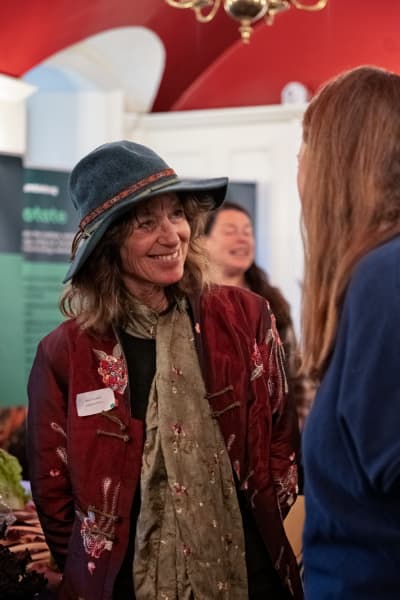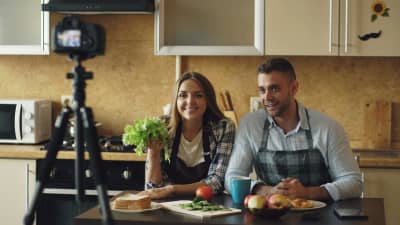Riki Therivel, of Food for Charities, tells the story of setting up the Leys Community Larder.
The Leys community larder finished its first five weeks of operation in December, and so I thought I would record how it all worked. The larder is only the second of its kind in the country, so it can be considered a work in progress for us.
July 2019
I contact FareShare with the aim of buying food for the Leys community fridge. FareShare is a national charity which aims to fight hunger through saving surplus food from the food industry that would otherwise have been wasted. The food is then redistributed to charities and community groups in order to support vulnerable people. The community fridge provides ‘open access’ food – food that anyone can take – in the most deprived estate in Oxford. ‘Open access’ food is important because lots of people who are not on benefits are still struggling to feed themselves and their families.
Good Food Oxford has identified the Leys area as lacking affordable and healthy food. Local convenience stores are expensive, in part because 40% of Leys residents do not have access to a car, so larger supermarkets are less accessible. I had fund-raised to buy a year’s worth of food for the Leys community fridge because our existing suppliers were struggling to keep the fridges full. Claire Hughes from FareShare’s partner organisation, SOFEA, comes back to me with a brilliant offer: “If you provide a venue and volunteers, we’ll provide free food and all the admin work for a community larder”.
A community larder is like a food club. Members pay a monthly fee of £8.66 (or twice that for a family membership), and in return they get access to a cafe, a children’s play area, several events per year, and up to 10 (20 for families) free items of food per week, plus free fruit and vegetables. The aim of the larder is primarily to reduce food waste through utilising the surplus food from supermarkets and wholesalers, but also to build community spirit, and get food to people who can use it. The cost of membership pays for SOFEA’s educational programme, the warehouse and transport of the food, and for the running of the membership administration.
SOFEA also works with young people who are struggling in traditional education. In the morning the young people have classes, and in the afternoon they work at the FareShare depot in Didcot, managing the surplus food from supermarkets. And so, with the help of SOFEA and Oxford City Council, the Leys Community Larder was born.
August and September 2019
Hollie and Jayne (from Oxford City Council) and I visit the Didcot Community Larder – the first in the country – several times, and I make a little video of it:
After the visits, Oxford City Council offers to provide a free room at the Blackbird Leys community centre on Wednesdays 3-5pm… but is there enough interest in a community larder, and will there be enough volunteers?
11 September 2019
We have a meeting about the idea of a community larder at the community centre. About 25 people show up, and half a dozen possible volunteers come forward. Luckily, most of the volunteers are local, which means that there would be local ‘ownership’ of the larder. Looks like it’s a goer! From now on, things move very quickly.
25 September 2019
Claire Hughes runs a volunteer induction where she and colleagues explain what SOFEA does, where the food comes from, what kind of food will be provided, what volunteering will involve etc. About 8 volunteers show up, probably helped by the fact that volunteers get a free (individual) membership. We agree that volunteers will get red T shirts with the Oxford City Council and SOFEA logo.
2 October 2019
We have a ‘mock larder’. SOFEA bring some food. We learn how to set it up on the tables and keep it off the ground, how to sign up members, how to deal with some possible problems, and how we might run the café and children’s area. The food from SOFEA is all in date, and gets split into about 25 groups, each with similar food in that group. This is so that members can quickly choose their 10 (individual) or 20 (family) items. Only some of the food from each group is out on the tables, with more kept behind to replenish the tables over the course of the two-hour larder. We want people coming later to have as good a selection of food as people coming earlier.

We debate whether to open the larder at 2:30pm to allow members to pick up food before they pick up their kids from school, or at 3:30pm so that people can drop in after picking up their kids. We think that people will want to be in and out quickly, so in the end we opt to stick with 3-5pm. That turns out to be a good decision, as people tend to trickle in from 3pm, and bring their kids to play in the children’s play area while they get their food, which makes for a nice atmosphere.

We realise that running the larder isn’t quite as easy as “you provide the venue and volunteers and we’ll do all the rest”. We have to provide crates for people to pick up food in (which is free courtesy of Produce Warriors of Banbury), toys for the children’s play area, starter refreshments for the café, lots of laminated signs, the T shirts, and probably other things that we don’t yet know about.
We had advertised the mock larder, and about a dozen people come by to see whether they want to become members. All is ready for the big opening the next week.
9 October 2019
The grand opening! The T shirts have arrived and all the volunteers look the part.

OK, so we don’t get the giant crowds of people we were expecting. Maybe 15 people show up and half of them sign up to become members. But that’s still a start, and it’s fine while we are still getting used to organising the food and sorting out membership forms. This is a picture halfway through that day:

All the new members are delighted with the amount of food that they get. We tell them to tell their friends about the larder.
Late October 2019
I have been away from the larder for weeks 2 and 3, but have come back for week 4. It’s amazing to see the difference. In the interim, Food for Charities has bought floor tiles and pens for the children’s play area, as well as two urns for the café. SOFEA has also provided small crates to allow the 25-ish categories of food to be more easily laid out:

The volunteers are now used to setting up the room. More tables are being used for food, so a new table has been set up for checking in the old members and registering new members. The volunteers have got used to holding a meeting before the larder opens to discuss what works and what doesn’t. The topic this week is what is to be expected from volunteers in terms of punctuality, regularity of attendance etc.

By now, about 40 people have signed up for memberships, many having heard about the larder from friends. The first hour is BUSY! The children’s play area is very popular, with a volunteer watching several older children drawing, and a couple of toddlers playing on the mat. The second hour is noticeably quieter.
6 November 2019
By the end of week 5, 48 members have signed up, 8 volunteers run the larder, and SOFEA is providing loads of lovely food. There is so much food that we set up a ‘free food’ table of the stuff that otherwise might not go, like gherkins and cooked beets from M&S. Individuals leave with two bags per person, and people with family memberships leave with FOUR bags of food. The fruit and veg doesn’t all go, so the leftovers go to the community fridge.
There are rumours that a television station might be sending an interviewer to today’s larder. Before the larder opens, the volunteer meeting is about what key messages we want to send out about the larder in case we get interviewed. They are as follows;
- REDUCING WASTE - Using the larder helps to reduce food waste, as the food is sourced from the surplus from the food industry.
- BUILDING COMMUNITY - It helps to build the community, as the café and children’s play area provide people with opportunities to connect with local people.
- QUALITY PRODUCE - It provides really good food for a very reasonable membership cost.
- EVERYBODY WELCOME - The main aim of the larder is to save food that would otherwise have been wasted, and redistribute it to people who can use it. A beneficial by-product of this scheme is that it meets the needs of vulnerable people, through the provision of good quality food at a reasonable cost. However, the Leys community larder is for everyone – you don’t need to be on benefits to join!
The volunteers also practice explaining why they are volunteering. Some of the responses included; that it gets them out of the house, it allows them to meet new people and help their community, it helps them to learn new skills or because they enjoy it.
So far, it’s a brilliant start for the newest food venture in Oxford.
Please come down and see whether you’d like to become a member:
Every Wednesday 3-5pm
Blackbird Leys Community Centre, Oxford OX4 6HW



